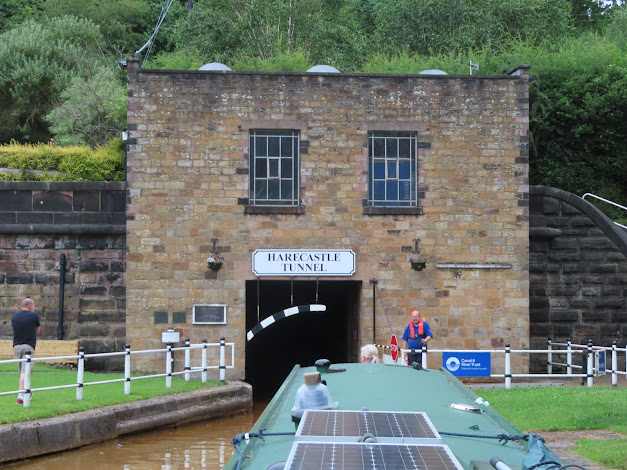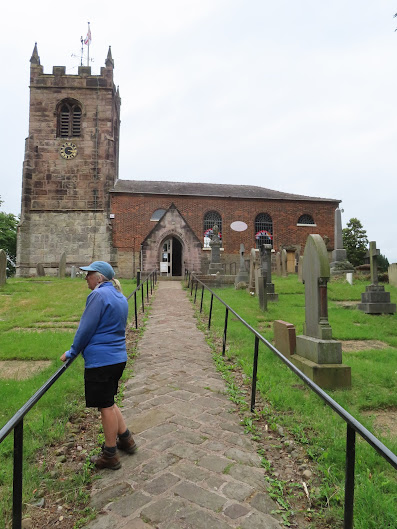We were up at 7am as there was a chance that we would be on our way just after 8am. The side of the tunnel that has the most boats waiting will have the first convoy and as there were 6 or 7 at the south end I suspected that we would be off at 8. We had our briefing, donned our life jackets and followed No.1 after 2 minutes.
The James Brindley tunnel was proving a bottleneck for traffic so Thomas Telford was asked to build a new tunnel. It took three years to build and was completed in 1827. I'm not sure whether the several tunnels that led off the original tunnel that serviced numerous coal faces. These also channeled numerous springs into the canal augmenting the supply at the summit. Telford's tunnel had a tow path but there were few boat horses who would walk through a mile and three quarters long tunnel in the dark so leggers, or pullers were used too. Both tunnels worked together, one in either direction, until 1914 when subsidence in the Brindley tunnel forced it to close. There was then a great bottleneck and quickly a towage service started using a electric battery tug. This soon changed to a tug powered by an overhead electric cable. They worked from 6am to 10am and moved about 200 boats a day in strings of 21. Where the car park is at the south portal was where the power station was. By the 1950's most boats were diesel powered and the tug was dispensed with. However with the length of the tunnel, number of boats and the lack of ventilation it became very poor to work in. In 1954 the forced ventilation was installed in the brick building above the entrance. Once the boats are in the tunnel these air tight gates are closed and the fans started that provide forced ventilation.
The tunnel isn't very wet, or cold as it is so long it maintains a temperature of about 15C. When the doors close and the fans start the relative humidity changes and there is about 2 minutes of dense fog! Quite disconcerting really. We have made it out in under 40 minuets and it isn't raining!
You are soon at the junction with the Macclesfield Canal at Hardings Wood. The finger post points to the left, we are heading straight on. The black sign states that the sign post was provided by the Macclesfield Canal Society with funds raised by the Stoke on Trent Inland Waterway Society to celebrate 30 years since the Cheshire Ring reopened in 1974.
The convoy No.1 had gone down the right hand lock, much of the locks down 'Heartbreak Hill' are duplicated to speed traffic up. As there was a boat half way up the lock on the left we waited for him rather than waste water refilling the other lock.
Looking back we can see the entrance to the Macclesfield to the right, and a bit of chaos as a boat has just come out and several boats are trying to get to the locks, and others wanting to go off to Macclesfield. All sorted in the end.
After the first of the Red Bull Locks there is a bit of a way to the next. Where there is a low bridge to the right was the entrance to a small arm that serviced the gas works there. Just a little further on was another arm that led to the Albion Iron Foundry.
It is slightly weird at the next lock as it takes you down under the Macclesfield Canal going over in the Poole Aqueduct. (The blue brick bridge structure).
Next comes the Red Bull Services. It seems there is an obvious wharf and warehouse building here with two cranes. The services are at the far end, and there are two taps. As they were free we stopped and topped up and were away again before anybody passed us.
The duplicated locks must have been a godsend to the working boatmen if there were 200 hundred boats a day passing. We passed through the six locks and tied up at Church Lawton. We had originally thought to visit Rode Hall, but they aren't open on Tuesdays. We stopped anyway as there was a chance of rain later, and if it didn't then I was going to wash the st'bd side after doing the paint work.
It didn't rain, so I set to washing the side. On the left is the before and on the right the after. Can you tell the difference? You can see one of the patches of red paint I did the other day. It was filthy, but will look so much better when I get round to polishing the hell out of it.
After lunch we decided to go for a short walk. From the towpath we crossed a field to All Saints' Church at Church Lawton. There was a church herein 1180. It developed over the years and by 1536 the tower was built. In 1652 there was a massive thunderstorm and hail that killed hundreds of animals. There was a service on and for some reason there were people in the belfry, watching the weather, ringing bells or there to see the service. After the storm passed eleven in the tower had been killed by a lightning strike.The nave of the church was built in 1803 and makes the church light and bright. There are some manorial hatchments that were presented in the 19th century on the death of male members of the Lawton family. The graveyard has some interesting memorials to read too.
Lawton Hall estate was owned by the Lawton family since the 13th century. The present building was erected around 1600 but the facade and wings date from the middle of the 17th century. In 1906 it was used as an hotel although still owned by the Lawton family. It was used by the Civil Defence in WWII. From 1950 to 1986 it was a school and was then going to a hotel again but never once. At this time it was damaged by fire. in 1999 a property developing company bought it and converted it to house and apartments and the same with the outbuildings. Houses were built on some land too.
The lake was well hidden by trees with few views, but it looked very blue to me. The walk was very pleasant through the woods.
This pub, the Bleeding Wolf was erected in the 1930's it was, and still is, owned by Robinson's and they built it behind the old pub and didn't knock it down until this one was ready. You can see the figure of a wold in thatch on the ridge. The pub is named after a local story. King John was hunting locally when he got separated from the others and fell from his horse that was frightened by a large wolf. A local woodsman came across the scene and killed the wolf. King John showed his gratitude by saying he could have all the land he could walk over in a week. The woodman, name of Lawton, took him at his word and covered as much ground as he could and hence won the estate. The pub was built on the spot that the wolf was killed.
Back to the church via some pasture and maize growing, and almost at the boat. I needed to have a walk or I think I will be even stiffer than I am now. I remember why I don't like washing boats, or even cars!!
















No comments:
Post a Comment